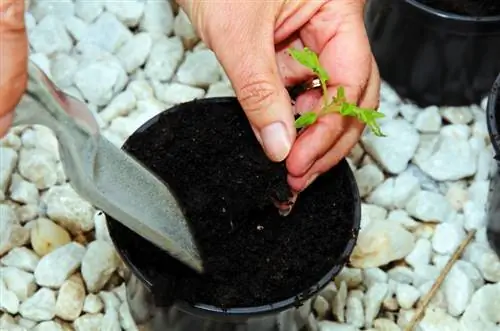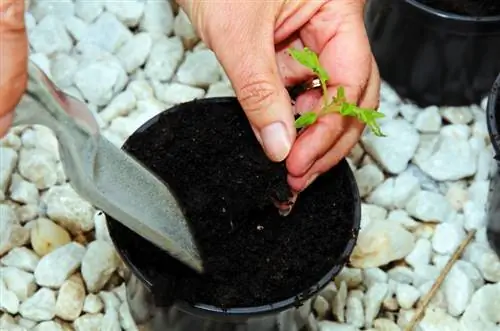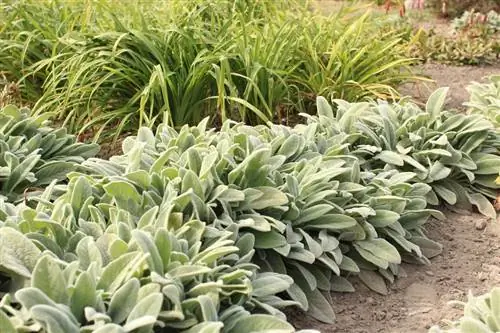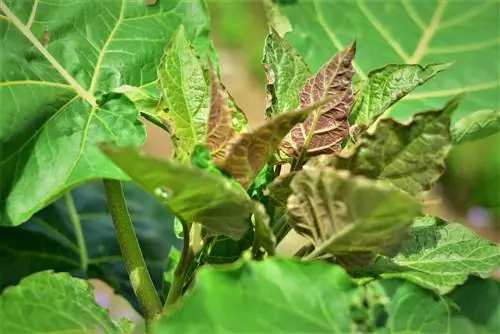- Author admin [email protected].
- Public 2023-12-16 16:46.
- Last modified 2025-06-01 06:02.
Skillful sowing is rewarded with vital tomato seedlings that show dynamic growth. Before moving into the open air, pricking is on the agenda. The following instructions show in detail how to do it.

How correctly to prick tomatoes?
When planting tomatoes, pay attention to the first pair of “real” leaves and use nutrient-rich soil mixture. Separate the seedlings carefully, shorten roots that are too long and plant them in pots down to the cotyledons. The plants then recover in partial shade.
Time is obvious
Experienced hobby gardeners do not prick tomato plants according to a firmly cemented schedule. Rather, pay attention to a visual identification mark that signals the correct date for isolation. If the first 'real' pair of leaves grows above the two cotyledons, the time is ripe. The visual difference between the two types of leaves is so clear that even complete beginners can have no doubt.
An exemplary soil for pricking out tomato plants
The sown seeds of tomato plants must first show what they are made of in a lean substrate. After pricking out, more nutritious soil is available for the maturing seedlings, because the tiny ones should reach a height of 30 to 40 centimeters by the time they are planted out in May. For the second phase of cultivation, these soil mixtures are recommended:
- Vegetable soil from the garden center, additionally thinned with the help of quartz sand, peat, or perlite
- commercial standard pricking soil based on green waste compost
- Own mixture of 1 part garden soil, bark humus and sand with 3 parts compost and 4 parts perlite, polystyrene beads or peat
In order to guarantee freedom from germs, the soil mixture is sterilized. This way you can ensure that there are no pathogens of diseases or eggs of pests hiding in it. Pour the soil into a fireproof bowl and place it in the oven at 150 degrees for 30 minutes or in the microwave at 750-800 watts for 10 minutes.
Uncomplicated pricking with the right accessories
The list of accessories for pricking out tomato plants is short; Nevertheless, every position contributes to the successful completion of the somewhat delicate procedure. It definitely makes sense to have a special pricking stick (€3.00 on Amazon) made of wood, metal or plastic. The tool only costs a few euros, but its functionality surpasses that of any makeshift method. The following variants are shortlisted as suitable planters:
- Clay pots with a diameter of 10 centimeters
- 9-centimeter plastic pots
- Maxi peat spring pots from Jiffy
Clay pots are watered thoroughly before use so that they do not remove moisture from the tomato plants. Plastic pots are only suitable with a bottom opening for water drainage to prevent waterlogging. If you plant in peat pots, later plant them together with the tomato plants in the bed or pot.
Stress-free pricking - step-by-step instructions
Tomato plants are never more fragile than when they are being pricked out. It is therefore advisable to transplant each seedling individually. The plants are watered thoroughly two to three hours beforehand, which makes the entire work process easier. Fill the pots with substrate about 5 centimeters high. If you use clay or plastic containers, place drainage made of pebbles or grit through the bottom opening. This is how it continues:
- loose up the soil around the seedling with the pricking stick
- lift the plant out and examine the roots
- shorten roots that are too long with your fingernails to a length of 2 centimeters
- Use the pricking stick to make a depression in the substrate to insert the seedling
- fill in the remaining soil up to the cotyledons and press down
The substrate ideally forms a small turtleneck around the stem below the cotyledons. Since tomato plants are capable of forming adventitious roots at this point, they promote stability for further growth. If these are grafted seedlings, the grafting area must not be covered with soil. Last but not least, water the younglings with room temperature water.
Appropriate care after pricking
The tomato plants are allowed to recover in a warm place in partial shade for the first three to four days after pricking out. Only then do they move to a bright location. To ensure that the young plants do not rot, temperatures and lighting conditions must be kept in a suitable balance. The higher the mercury column rises, the more light must be available.
Tomato plants should not be exposed to direct sunlight during this phase of growth. Only in the week before moving outdoors are they accustomed to direct sunlight for a few hours during the day. Constant watering is particularly important to compensate for moisture loss. Tomato plants do not receive fertilizer until the second week after planting at the earliest.
Tips & Tricks
If you want to offer your tomato seedlings the ultimate substrate, use vermiculite as the seed soil. The natural silicate made from aluminum, iron and magnesium is mineral, germ-free and tops any soil mixture. Vermiculite promotes root growth while retaining water and providing excellent ventilation. However, it has its price at 39 euros for 100 liters.






